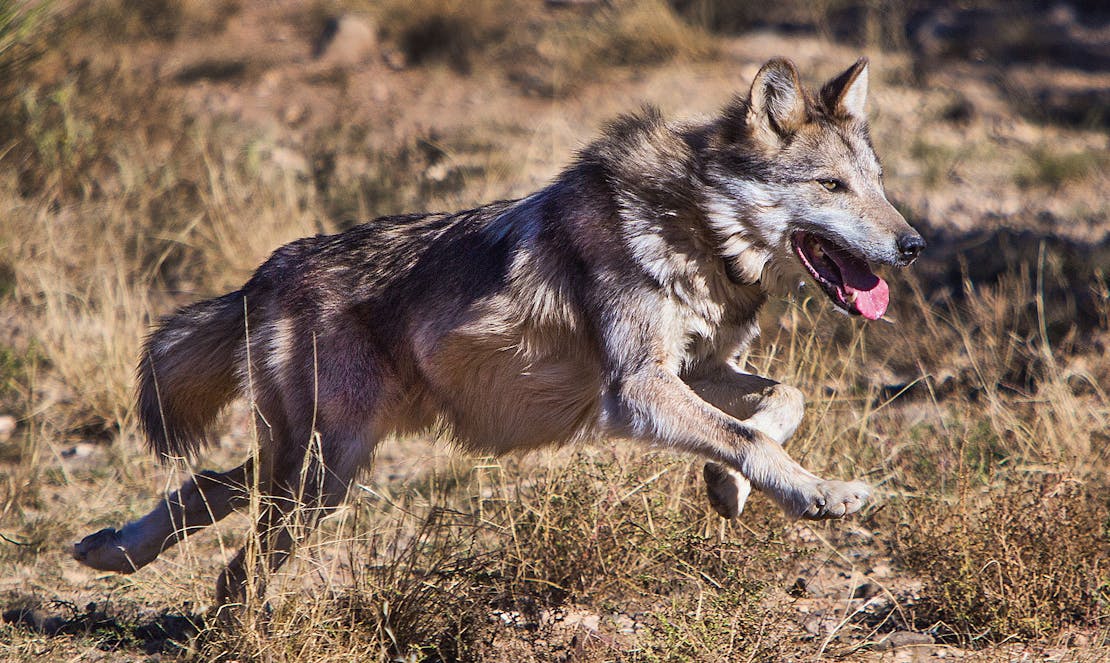& How Defenders of Wildlife has Led the Way in Wolf Conservation
It’s an eerily dark night. A crisp fall air rustles the last clinging leaves on the trees and scatters several crunchy leaves on the forest floor. A low howl rises in the distance. It’s the third week of October and we are running into National Wolf Awareness Week.
Defenders of Wildlife established National Wolf Awareness Week in 1996. Having a national commemoration for these incredible, but often misunderstood animals provides the space to drive deeper meaningful conversations about their ecological importance and why they need continued protection.
There are two widely recognized species of wolves living in the U.S.: gray wolves (Canis lupus) and Red Wolves (Canis rufus). Defenders currently works with both, including the subspecies, Mexican gray wolf (Canis lupus baileyi). Wolves play a key role in keeping ecosystems healthy. They keep large ungulate populations, like elk and deer, in check which prevents overgrazing and makes space for other species.
Red wolves are particularly unique because their entire historical range is within what is now the U.S. They were also one of the first species listed under the Endangered Species Act but were declared extinct in the wild within a few years of the listing.
Unfortunately, wolf species of the U.S. were hunted to near extinction in the early 1900s. It wasn’t until decades later the fight to bring them back began. Red wolves were the first carnivores reintroduced to the wild in the U.S. under the ESA in 1987 to the Alligator River National Wildlife Refuge in eastern North Carolina.
Less than a decade later, in 1995, gray wolves were reintroduced to Yellowstone National Park and central Idaho. This was the first time they had roamed the northern Rockies in 70 years. In 1998, the U.S. Fish and Wildlife Service, led by Jamie Rappaport Clark (now president of Defenders), reintroduced Mexican gray wolves to Arizona. And most recently, Colorado voters supported a ballot initiative to reintroduce gray wolves to the state by December 2023. This is the first time U.S. voters have ever directed a state wildlife agency to reintroduce a species.
Wolf restoration has been important to Defenders since conversations around reintroductions began. As the first national conservation group to call for wolf reintroduction in Yellowstone Park, we played an active role in the 1995 and 1996 reintroductions. We also led the efforts to pass the ballot initiative in Colorado. But our work doesn’t stop at bringing wolves back.
Defenders has also battled in courtrooms and on Capitol Hill to maintain legal protections for wolves. When the federal government prematurely and without scientific backing, removed protections for all wolves except the Mexican gray and Red Wolves in 2020, Defenders filed a lawsuit. As a result, protections for all but the northern Rockies wolf populations were restored. Defenders also took part in a lawsuit against the USFWS for pulling back on its management efforts for Red Wolves. A settlement was successfully negotiated in August 2023 and, as a result, USFWS is now legally committed to progressing Red Wolf recovery efforts through 2030.
Additionally, Defenders works with communities to educate them about peaceful coexistence with wolves and other wildlife. One key method of coexistence is utilizing non-lethal tools to minimize conflict. Since 2002, Defenders has supported range riders (those who provide a human presence on rangelands to help keep larger carnivores, like wolves, from preying on cattle) for projects in the Mexican gray wolf recovery area. Other non-lethal tools, which we help implement across all regions, include moving livestock away from wolf dens, erecting special fencing and noise deterrents – all of which are proven techniques to keep wolves and livestock safe.
Despite the restoration and recovery efforts in play, there’s still so much for us to do to ensure a thriving future for wolves, and we can’t do it without you. National Wolf Awareness Week dedicates seven days of the year to educating the public about wolves and their plight. So, we hope you will share what you learn about wolves this week with others. This week may be shrouded under a new moon, but we all can bring light to the mystery and beauty of wolves.
See our list below for opportunities to get involved and to support wolves this week and beyond.
National Wolf Awareness Week 2023
Keep your ears perked on Monday, Oct. 16 for Eric Clewis’, Senior Representative in the Northern Rockies, stories of the past and present state of wolves in this region.
Look forward to the future of gray wolves in Colorado on Tuesday, Oct. 17.
Meet Heather Clarkson, Regional Outreach Representative in the Southeast, on Wednesday, Oct. 18. Be sure to check out her blog about using art to speak about Red Wolf recovery in North Carolina.
Join Kaitie Schneider, Colorado Wolf Representative, on Thursday, Oct. 19 for a free virtual paint night. Register here – space is limited!
Run into the weekend with Craig Miller, Senior Representative in Arizona, on Friday, Oct. 20. Check out this blog with field notes from Mexican gray wolf technicians.










